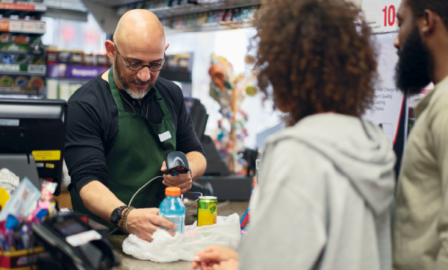The Evolution of Direct Store Delivery Technology
Technology has revolutionized Direct Store Delivery (DSD), transforming it into a more efficient and real-time data-driven strategy for improving consumer satisfaction, optimizing supply chain operations, and driving sales. Modern Direct Store Delivery technology solutions leverage cutting-edge tools such as mobile applications, GPS tracking, geofencing, telematics, and cloud-based platforms to streamline delivery routes, improve inventory management and competitive insights, measure driver behavior, and ensure real-time visibility into product availability and freshness.
Advanced Direct Store Delivery Technology
These technological advancements allow manufacturers to make data-informed decisions, gathering invaluable market intelligence to quickly respond to shifts in consumer preferences, competitive promotions, in-store trends, and more. DSD now offers not only the assurance of product freshness but also greater agility, with predictive analytics and AI-based systems optimizing stock replenishment and reducing the likelihood of out-of-stock situations. Deploying advanced DSD technologies can also lead to stronger relationships with retail partners, as they can offer more tailored, data-backed support.
Retailers benefit from DSD’s technology enhancements as well, as integrated software systems provide real-time insights into sales patterns and inventory levels, allowing for more strategic product placement and better merchandising decisions. This increases customer satisfaction, foot traffic, and overall sales performance.
How Technology Enables DSD Optimization
Despite its advantages, DSD presents unique challenges, particularly in logistics and scalability. Operating a network of direct deliveries requires significant infrastructure, including a well-managed fleet of vehicles, trained drivers, and sophisticated route optimization technology. Rising fuel and insurance prices, vehicle maintenance costs, and labor costs further complicate budgeting and operations, making it essential to adopt tools that help manage these variables.
DSD also introduces inventory management and scheduling complexity, as frequent product replenishment requires precise coordination across multiple stakeholders. Manufacturers, 3PLs, drivers, and retailers must work in unison, often relying on real-time data and communication to avoid delays and inefficiencies. Without modern, tech-enabled solutions, these challenges can lead to miscommunications, delivery delays, or costly inefficiencies, especially compared to traditional distribution models. To overcome these hurdles, companies need advanced systems capable of automating processes, optimizing routes, and providing real-time delivery updates.
Advanced route planning and dispatching software and mobile devices facilitate real-time tracking and communication between delivery drivers and retail locations, ensuring accuracy and efficiency throughout delivery. These systems optimize route planning by analyzing various factors such as traffic patterns, delivery windows, and geographic regions. This capability enables companies to determine the most efficient routes, reducing travel time and fuel costs while improving on-time deliveries.
Real-time inventory management tools allow businesses to monitor stock levels across the supply chain as they fluctuate throughout the day. Integration with or access to retail Point of Sale (POS) data can provide manufacturers with real-time store stock levels. Solutions like Radio-Frequency Identification (RFID) tags automate inventory management, allowing businesses to maintain up-to-date stock records and minimize errors.
Telematics has become essential for optimizing routes, reducing vehicle wear and tear, minimizing fuel consumption, and improving overall delivery time. Through telematics, companies can gain valuable insight into driving behavior, such as driving speed, acceleration, turning speeds, braking patterns, and adherence to routes. This improves overall fleet efficiency and ensures driver safety and compliance with regulations, which is increasingly important as rising insurance costs and stricter standards from insurance companies demand better oversight of delivery vehicle operations.
Artificial Intelligence (AI) is also becoming increasingly integral to the DSD model. AI-driven demand forecasting enables manufacturers to accurately anticipate consumer needs, leading to improved inventory management and reduced stockouts. Companies like Bimbo Bakeries have successfully integrated AI into their DSD operations, enhancing forecasting precision and route planning. By analyzing historical sales data, real-time depletion, weather patterns, market trends, and social media influences, AI-powered systems allow businesses to adapt to fluctuating demand with agility and precision.
User adoption is paramount to fully realizing the benefits of these technologies. Organizational Change Management (OCM) and adequate training ensure all team members can seamlessly integrate these tools into their daily workflows. Making technology intuitive and easy to use, coupled with ongoing support to help users navigate change, is critical for securing their commitment. Ultimately, winning the hearts and minds of users is vital for embracing these advancements and driving success in DSD operations.
Getting Started with DSD
As technology advances, DSD is poised for further enhancements. Innovations in real-time tracking, route optimization, and AI-powered demand forecasting will augment the responsiveness of DSD operations. With the growth of eCommerce and evolving consumer preferences, DSD will empower retailers to meet increasing demands for rapid replenishment and fresh products. As consumer expectations for faster, fresher products rise, DSD will remain a valuable strategy for retailers striving to stay competitive.
It’s critical to recognize that implementing new technologies requires careful change management. Ensuring the smooth adoption of these tools by end-users and syncing surrounding processes to these technologies is key to building a best-in-class DSD model.
Contact our team for help getting started with DSD technology.
Subscribe to Clarkston's Insights





